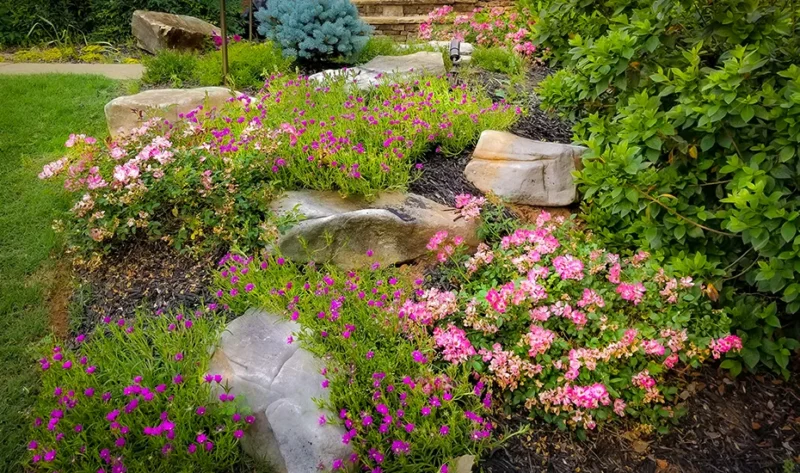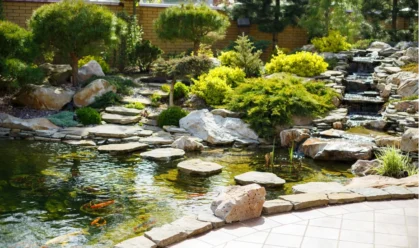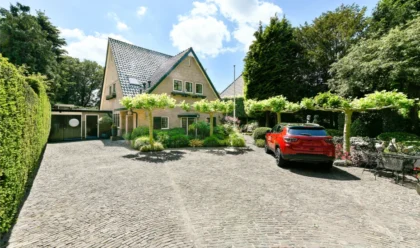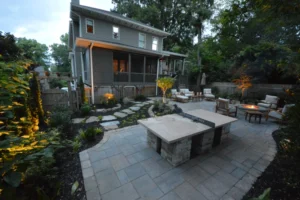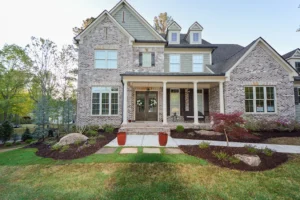Atlanta is a lively city, and its diversity in landscape makes it an ideal location for creating beautiful gardens. Whether you have a large garden or a small space, you can always make the outdoors look as though it belongs to you by doing some proper designing and planning.
This ultimate guide will provide all the necessary information on how to create your own paradise, from understanding the specifics of your land plot to choosing ecologically friendly plants. The various types of gardens we shall discuss include different options in hardscaping and maintenance hints to help you design outside spaces that are uniquely yours and improve your standards of living.

Understanding Your Space: The Foundation of Your Garden
To start with the creative side of garden design, it is crucial to comprehend the unique elements that make up your outdoor area. Such information will help you decide how you would like your garden to grow and prosper.
- Assessing Your Outdoor Area: Start by carefully examining your yard or patio. Evaluate its size, shape, and compass direction. If you have a north-facing space, expect less sunlight to reach it than a south-facing one; thus, the plants chosen should be able to perform well under such conditions. Furthermore, any permanent structures within the immediate vicinity, such as fences, sheds, or trees, could influence the layout.
- Soil Analysis: To have healthy plant growth, we must determine the soil type in our gardens. Different plants do well in various soils. You can undertake a simple soil test or consult an expert gardener within the locality on pH levels, nutrient composition, and soil type, which can show what kind of vegetation can be grown.
- Sunlight Exposure: Note how much sun enters this area during the daytime. Many plants need at least 6 hours of sunshine daily, but some also flourish under shadowy circumstances. Create sunlight maps showing areas with full sun, partial sun, and full shade.
- Drainage: For this reason, it is crucial to have well-drained soil to avoid waterlogged roots. Observe how water flows on your land when it rains. If specific areas hold onto water, inadequate drainage should be resolved before planting.
- Defining Your Garden’s Purpose: What do you use the garden for? Are you seeking peace, hosting or growing vegetables? This will help you narrow your design efforts and plant choices.
- Setting a Budget and Timeline: Prepare a practical budget for your garden project. This will help you know what needs are of higher priority and make informed choices concerning materials and plants. In addition, decide on a time frame for which to finish your garden; this will allow you to be organized in managing expectations.

Garden Styles and Themes: Finding Your Inspiration
Now that you have a good grasp of your outdoor space delve into the world of garden styles and themes. With the right style, a backyard can become an oasis that reflects individual tastes.
Popular Garden Styles
- English Cottage Garden: Romantic and casual, this style includes blooms, curving paths and structures such as cottages.
- Contemporary Garden: This style is characterized by minimalism, with its focus on clean lines, geometric shapes, textures, and colors.
- Japanese Garden: These gardens are often characterized by a feeling of nature and peace. They include ponds, rocks, and flowers positioned carefully to achieve harmony.
- Mediterranean Garden: This type of garden is influenced by the warm Mediterranean weather with drought-resistant plants, stone walls, and terracotta pots.
- Tropical Garden: This style is very lush and exotic, bringing the tropics right into your backyard with vivid colors, palm trees, and tropical blooms.
Creating a Cohesive Theme
Even if one is attracted to a particular style, a unique theme can be created. Incorporate elements from your house’s architecture, favorite colors, or hobbies. For instance, you can create a garden that signifies your love for travel using plants from different countries or a patio shaped like a world map.
Incorporating Local Elements
Native plants should be included in an Atlanta garden. Because they are indigenous to the local climate, they need less care than other plants. They also provide shelter for wildlife.
Plant Selection: Bringing Your Garden to Life
Choose the right plants to make a vibrant garden that looks good, too. Atlanta has different climates that accommodate such desires based on individual interests, so people who want flowers in their homes have many options.
Selecting Plants for Atlanta’s Climate
The reason Atlanta has a favorable climate for many plants is its hot summers and mild winters. When selecting your plant palette, think about the following factors:
- Sunlight: Pick plants that do well in the sunlight your garden receives.
- Soil Conditions: Choose plants that can grow best on your soil type and pH level.
- Water Requirements: Consider how much water each type of plant needs so that you don’t over or under-water any of them.
- Hardiness Zones: Ensure you pick plants that match Atlanta’s hardiness zone.

Balancing Native and Exotic Species
Incorporating native plants into your garden will help the environment and your maintenance routine. They need less attention since they are already adjusted to local conditions. In contrast, exotic species might contribute unique colors, textures, and other visual characteristics.
Creating Visual Interest
To create a dynamic garden, consider some of these features:
- Color: Pick different colored plants to make an appealing mixture.
- Texture: Combine plants with leaf textures that are smooth, rough, or feathery to add depth and interest.
- Height: Enriching your plants’ variety will help you generate layers, thus achieving visual interest.
Year-Round Interest
Consider incorporating plants with different blooming seasons for a beautiful garden throughout the year. Evergreens, ornamental grasses, and winter-interest plants can add color and texture during colder months.
Edible Gardens
If you enjoy fresh produce, consider incorporating edible plants into your garden. There are countless options, from herbs and vegetables to fruit trees.
You can create a vibrant and flourishing outdoor space by carefully selecting plants that suit your garden’s conditions and your preferences.
Hardscaping Elements: Defining Your Outdoor Space
Hardscaping involves incorporating non-living materials to structure and enhance your garden. These elements not only provide functionality but also contribute to the overall aesthetic appeal of your outdoor space.
The Role of Hardscaping
Hardscaping serves multiple purposes:’
- Defining Spaces: Creating distinct areas for relaxation, dining, or entertaining.
- Improving Functionality: Providing pathways, patios, and retaining walls for practical use.
- Enhancing Aesthetics: Adding visual interest with stone, brick, or wood materials.

Selecting Materials
The materials for your hardscaping elements should complement your garden’s style and your home’s architecture. Popular options include:
- Stone: Versatile and durable, stone can be used for patios, walkways, retaining walls, and water features.
- Brick: Adds a classic and timeless look to patios, walkways, and outdoor fireplaces.
- Concrete: Offers a modern and clean appearance and is often used for patios, driveways, and walkways.
- Wood: Brings warmth and natural beauty to decks, pergolas, and arbors.
Designing Water Features
Water features add a soothing and dynamic element to any garden. Consider incorporating:
- Ponds: Create a tranquil oasis with fish, plants, and water lilies.
- Fountains: Offer a relaxing sound and visual focal point.
- Waterfalls: Add a sense of drama and energy to your outdoor space.
Incorporating Outdoor Living Spaces
Transform your garden into an extension of your home by creating inviting outdoor living areas:
- Patios: Perfect for dining, entertaining, and relaxing.
- Outdoor Kitchens: Equip your patio with a grill, refrigerator, and countertop for culinary adventures.
- Fire Pits: Create a cozy atmosphere for gatherings and roasting marshmallows.
By carefully selecting and combining hardscaping elements, you can create a functional and aesthetically pleasing outdoor space that complements your garden’s design.
Sustainable Gardening Practices: Creating an Eco-Friendly Oasis
Sustainable gardening involves minimizing your garden’s environmental impact while maximizing its benefits. Adopting eco-friendly practices can create a healthy ecosystem, conserve resources, and reduce your carbon footprint.
Benefits of Eco-Friendly Gardening
- Environmental Protection: Preserving biodiversity, reducing pollution, and conserving water.
- Cost Savings: Lowering expenses on fertilizers, pesticides, and water.
- Healthier Produce: Growing organic food free from harmful chemicals.
- Enhanced Garden Ecosystem: Attracting beneficial insects and wildlife.
Water Conservation Techniques
- Rainwater Harvesting: Collect rainwater in barrels for use in your garden.
- Efficient Irrigation: Use drip irrigation systems to deliver water directly to plant roots, minimizing evaporation.
- Mulching: Apply a layer of mulch to retain soil moisture and reduce evaporation.
- Plant Drought-Tolerant Species: Choose plants that are well-suited to your local climate and require less water.
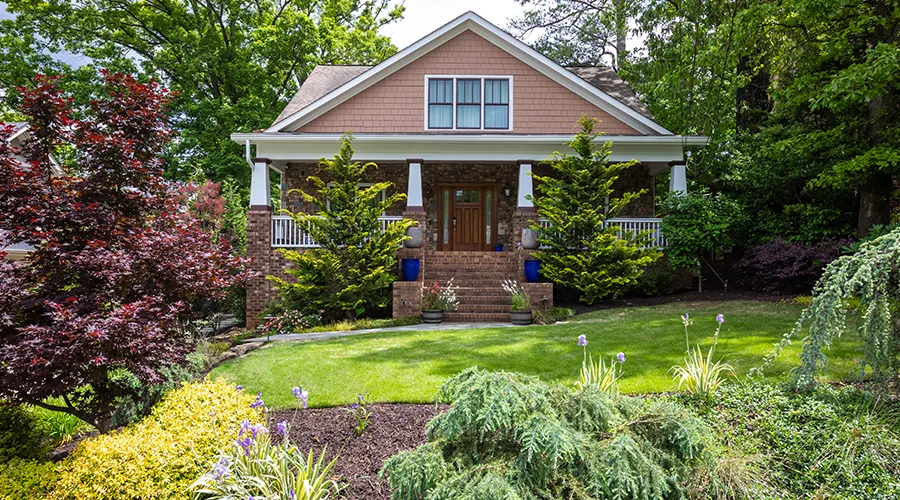
Organic Gardening and Soil Health
- Composting: To improve soil fertility, create nutrient-rich compost from kitchen scraps and yard waste.
- Cover Cropping: Plant cover crops to protect soil, prevent erosion, and add organic matter.
- Crop Rotation: Vary the types of plants you grow in different areas to maintain soil health and reduce pest and disease problems.
- Avoid Chemical Pesticides and Fertilizers: Opt for natural pest control methods and organic fertilizers.
Reducing Lawn Size and Embracing Alternatives
- Create Lawn Alternatives: Replace portions of your lawn with native plants, ground covers, or hardscaping.
- Smart Lawn Care: Mow less frequently, leave clippings on the lawn, and water efficiently.
Maintenance and Care: Nurturing Your Garden
Consistent care is essential for maintaining a thriving garden. Following these guidelines lets you keep your outdoor oasis looking its best year-round.
Essential Care for Different Plant Types
- Watering: Understand each plant’s water needs and adjust watering accordingly. Avoid overwatering, which can lead to root rot.
- Fertilizing: Regular fertilization provides plants with the necessary nutrients. Follow the recommended dosage and timing for each plant type.
- Pruning: Regularly prune plants to encourage growth, shape, and remove dead or diseased parts.
- Deadheading: Remove spent flowers to promote continuous blooming.
Pruning and Shaping Techniques
- Shearing: Use for hedges and shrubs to maintain a specific shape.
- Thinning: Remove entire branches to improve air circulation and light penetration.
- Heading Back: Cut back stems to encourage new growth.
Pest and Disease Management
- Regular Inspection: Monitor your plants for signs of pests and diseases.
- Prevention: Encourage beneficial insects by planting flowers that attract them.
- Organic Control Methods: Use natural remedies like insecticidal soap or neem oil for pest control.
- Disease Treatment: Consult a gardening expert for advice on specific diseases.
Seasonal Tasks
- Spring: Spring: tidy up garden beds, trim shrubs, top dress, and put in annuals.
- Summer: Regular watering and mulching keep moisture, pests, and diseases in check.
- Fall: Prepare for winter by trimming, feeding, and guarding soft plants.
- Winter: shield from frost and snow while raking leaves.

Conclusion
Making a beautiful and functional garden is an enjoyable undertaking that can turn your outdoor area into a sanctuary. With this guide, you have the knowledge and inspiration to create a garden that matches your style and improves your life.
Remember–planning, selecting plants carefully, and maintaining are key points for a successful garden. Begin by learning about your space constraints and what you want from your garden, then look at different styles or themes. Integrate hard landscaping materials into such areas to make them more user-friendly while ensuring that all of these practices are eco-friendly.
With commitment and imagination, it is possible to reproduce outside whatever nature has bestowed within it; beauty can be added even in places where none exists so far. Take the opportunity to try other ways; however, more important than anything else is enjoying the transformation journey of turning an empty yard into a flourishing gardens.













